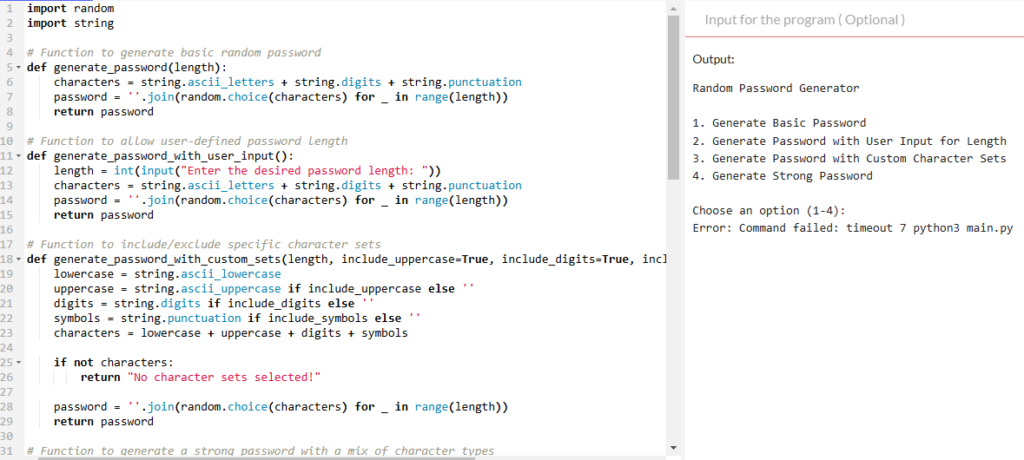Table of Contents
- Introduction
- Basic Implementation
- Customizing Password Length
- Including Different Character Sets
- Advanced Features
- Online Demo
- Best Practices for Password Generation
- Conclusion
- FAQ
Introduction
In today’s digital world, strong passwords are essential to protect your online accounts and sensitive information. Therefore, a random password generator helps create secure, unpredictable passwords to minimize the risk of hacking. In this guide, we’ll show you how to build a random password generator in Python, starting from basic implementations and progressing to customizable, secure features.

Basic Implementation
Core Logic
First, we’ll cover the core logic of a random password generator.
Core Logic
The foundation of a random password generator lies in creating a mix of characters using Python’s random module. For example, below is the basic implementation of the generator
Code
import random
import string
def generate_password(length):
characters = string.ascii_letters + string.digits + string.punctuation
password = ''.join(random.choice(characters) for _ in range(length))
return password
# Example usage
print("Generated Password:", generate_password(12))
Explanation
- Modules Used:
random.choice: Picks random characters.string.ascii_letters: Includes uppercase and lowercase alphabets.string.digits: Includes numbers.string.punctuation: Includes symbols.
- Password Generation: Combines characters into a password of the specified length.
Customizing Password Length
Enhancing User Control
Next, Allowing users to define password length adds flexibility to the generator. In other words, this enables personalization based on the user’s specific needs.
Updated Code
def generate_password():
length = int(input("Enter the desired password length: "))
characters = string.ascii_letters + string.digits + string.punctuation
password = ''.join(random.choice(characters) for _ in range(length))
return password
print("Generated Password:", generate_password())
Explanation
- Dynamic Length: Password length is taken as input.
- Improved Usability: Ensures user-defined customization.
Including Different Character Sets
Selective Character Inclusion
Users may want to include or exclude certain types of characters (e.g., symbols).
Updated Code
def generate_password(length, include_uppercase=True, include_digits=True, include_symbols=True):
lowercase = string.ascii_lowercase
uppercase = string.ascii_uppercase if include_uppercase else ''
digits = string.digits if include_digits else ''
symbols = string.punctuation if include_symbols else ''
characters = lowercase + uppercase + digits + symbols
if not characters:
return "No character sets selected!"
password = ''.join(random.choice(characters) for _ in range(length))
return password
# Example usage
print("Generated Password:", generate_password(12, include_uppercase=False, include_symbols=False))
Explanation
- Custom Sets: Users can choose which character types to include.
- Validation: Ensures at least one set is selected.
Advanced Features
Ensuring a Strong Password
Add features to guarantee a minimum number of each character type for enhanced security.
Code Example
def generate_strong_password(length):
if length < 4:
return "Password length must be at least 4 for strong password!"
lowercase = random.choice(string.ascii_lowercase)
uppercase = random.choice(string.ascii_uppercase)
digit = random.choice(string.digits)
symbol = random.choice(string.punctuation)
remaining = ''.join(random.choice(string.ascii_letters + string.digits + string.punctuation) for _ in range(length - 4))
password = lowercase + uppercase + digit + symbol + remaining
password = ''.join(random.sample(password, len(password))) # Shuffle the characters
return password
print("Generated Strong Password:", generate_strong_password(12))
Online Demo
thus Try the code live using an online Python compiler like OneCompiler. Simply paste the code above into the environment and run it.
Best Practices for Password Generation
- Length Matters: Use passwords with a minimum of 12 characters.
- Character Variety: Include letters, digits, and symbols.
- Avoid Common Patterns: Never use predictable sequences like “12345”.
- Frequent Updates: Change passwords periodically.
Conclusion
In conclusion, you’ve learned how to create a robust random password generator in Python. From basic implementations to advanced features, you now have the tools to enhance password security effectively.
FAQ
1. What is the minimum password length recommended?
12 characters are generally recommended for a strong password.
2. Can I exclude symbols from the password?
Yes, the code allows customization to exclude symbols if needed.
3. Why is shuffling characters important?
Shuffling ensures that even with fixed patterns (e.g., one uppercase, one digit), the password remains unpredictable.
By following the steps above, you can create a secure and flexible password generator tailored to your needs.
